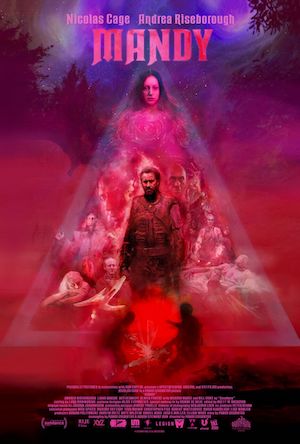

[Rating: Swiss Fist]
Mandy is a blood-spattered, acid-dosed grindhouse fever dream of a film that takes far too long to rev up, but never lets its foot off the pedal when it does. The story of one man’s revenge quest against the sex-crazed Jesus cult that wrongs him, this sophomore effort by director Panos Cosmatos boasts a lot of style, yet precious little substance. Indeed, even a mostly subdued, measured performance by Nicolas Cage in a leading role can’t right this ship, despite a dynamite third act and more than a few striking visuals.
Mandy opens in logging country circa 1983, where axe-man Red Miller (Cage) leads a quiet, domestic life with his girlfriend, Mandy (Andrea Riseborough). The pair watch trashy network T.V., talk about the universe, read pulp sci-fi, and enjoy the immense solitude of their cabin in the woods. This tranquil paradise is shattered when a religious cult led by an LSD-crazed “minister” named Jeremiah (Linus Roache) happens upon Mandy one day. Jeremiah becomes enraptured with the woman, and leads his brood to Red and Mandy’s cabin, where the group summon hell beasts on motorcycles and commit horrible acts of violence on the pair.
Without moving too far into spoiler territory, it should just be said that when the dust settles Red finds himself in a desperate position with vengeance in his heart. He goes to see an old friend, Caruthers (Bill Duke), who gives Red all the intel and hardware needed to attain satisfaction. What follows is an axe-spinning, chainsaw ripping, blood-soaked orgy of violence and terror scored to heavy synth and shot in wide, luscious anamorphic. It feels like a callback to the late-70s and early-80s slasher films of John Carpenter and Wes Craven, with just a dash of Lars von Trier thrown in for good measure.
All of this means that the look and sound of Mandy is almost its own character, as it has a period-appropriate horror aesthetic that meshes well with the time, place, and content. The movie also revels in its violence in a way that makes it reminiscent of Tarantino, or even S. Craig Zahler. Comparing Cosmatos with the latter’s work in Bone Tomahawk and Brawl in Cell Block 99 feels even more apt, as the blood and gore is mean spirited, and with less of a tongue-in-cheek sentiment attached to it. There’s an ugliness to these worlds, and even though the directors don’t share a visual look, there’s a shared narrative understanding that both seem to possess.
 In Zahler’s hands, this can work: the lack of fun or joie de vivre feels consistent and rooted in a specific place and situation. Yet with Cosmatos, this tone drifts in and out of focus, and never allows the audience to settle into the story’s particular crimson-stained rhythm. It doesn’t help that the first hour of Mandy drags with the slow-moving pace of a wounded sloth, and that Cage is emotionally bottled up early on, only to explode into full on Cage-ness more than halfway through.
In Zahler’s hands, this can work: the lack of fun or joie de vivre feels consistent and rooted in a specific place and situation. Yet with Cosmatos, this tone drifts in and out of focus, and never allows the audience to settle into the story’s particular crimson-stained rhythm. It doesn’t help that the first hour of Mandy drags with the slow-moving pace of a wounded sloth, and that Cage is emotionally bottled up early on, only to explode into full on Cage-ness more than halfway through.
At 121 minutes, Mandy feels at least a half hour too long. Scenes go on for far past the moment they need to in order to convey the gist, and other portions seem to exist solely for the creation of atmosphere. This latter point is worth dwelling upon for a second, as there’s more than enough here in terms of music, visual aesthetics, and honestly good acting work on Cage’s part to get the audience where they need to emotionally be for all of this. Atmosphere is like the presentation of a plate at a restaurant: a little goes a long way, and what works is the product of what is around the dish, not what’s in it. It feels like Cosmatos tried to bake the atmosphere into the finished product rather than let it do its work on the fringes, and his film suffers for it.
There’s also world-building inconsistencies that keep Mandy from sticking its landing, and pull it back and forth between what may well be the real world, and a heightened reality where actual monsters exist. The Weird Science-esque biker gang that is roused out of the ether of the night to terrorize Red and Mandy seem supernatural, and act as such, yet at other times appear to be mere mortals. The script also doesn’t seem to know what to make of Jeremiah and his gang of zealots, as they appear to be little more than acid-crazed lunatics one minute, yet capable of summoning actual evil forces at others. Whether there are monsters or demons at work here doesn’t really matter, but the inconsistency of the film when dealing with all of this does become problematic if one takes a step back to look at it all from a distance.
 Which is all to say that if a person makes it through the first hour of this thing, and puts aside logic, reason, or narrative cohesion, there’s a lot to enjoy. Whether a person digs a more subdued, contemplative Nicolas Cage or the wild-eyed Bad Lieutenant version doesn’t matter: both are on display here. There’s a scene in a bathroom with Cage and a bottle of vodka that will undoubtedly make it into the man’s in memoriam Oscar reel, and it alone makes this flick worth watching.
Which is all to say that if a person makes it through the first hour of this thing, and puts aside logic, reason, or narrative cohesion, there’s a lot to enjoy. Whether a person digs a more subdued, contemplative Nicolas Cage or the wild-eyed Bad Lieutenant version doesn’t matter: both are on display here. There’s a scene in a bathroom with Cage and a bottle of vodka that will undoubtedly make it into the man’s in memoriam Oscar reel, and it alone makes this flick worth watching.
Still, it’s hard to recommend Mandy, what with its glacial pacing and scene after scene that scream out for a competent editor. What it does well (i.e., its presentation of what it is like to be on acid, axe murdering, chainsaw fighting, and the full range of Nicolas Cage’s acting work), it nails, yet what it gets wrong (an hour long 1st act, an inability to trim scenes down, inconsistent world-building) overshadows much of the rest. Opening this week after making a splash at the Sundance Film Festival, Mandy will be an interesting one to watch. Much like its star, Nicolas Cage, that might be enough to sustain it.





Comments on this entry are closed.